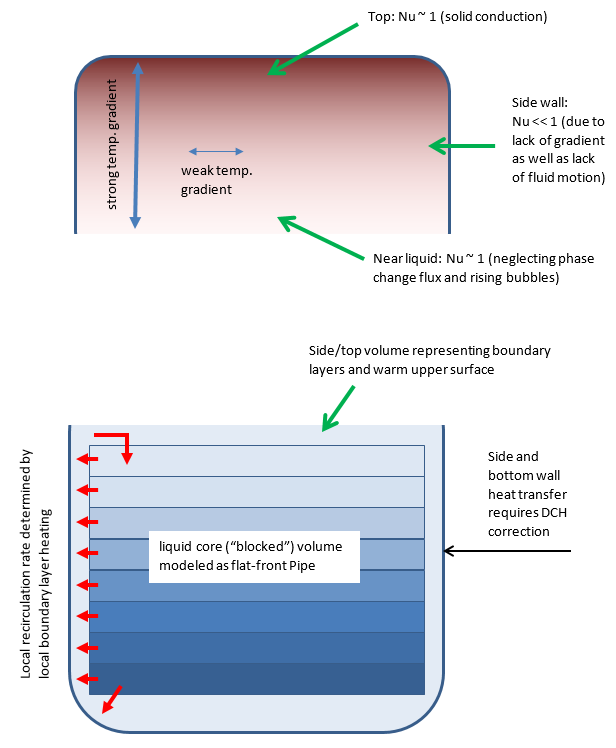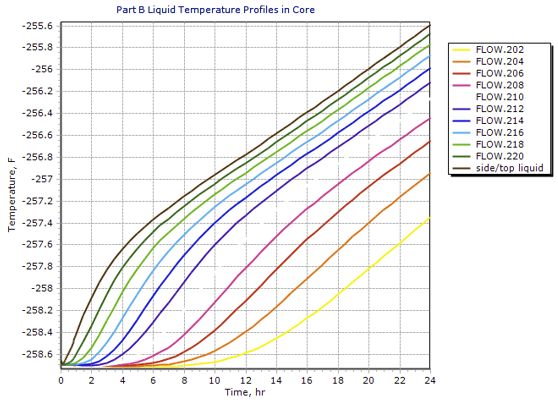Brent Cullimore
You will of course remember this blog post from almost three years ago, “Why Stratified Tanks Stir Me Up.” I mean, who wouldn’t remember a complaint-ridden, anguish-filled, and slyly-insulting post by an aging technologist who fears that the complexities of two-phase tank dynamics under quasi-steady conditions won’t be solved in his lifetime?
And how could you forget Fun with FloCAD Compartments favorites like “It’s a bird! It’s a plane!” and “Geek Squared?”
Thermally-stratified tanks are encountered in long-term storage of cryogenic liquids, amongst other applications. All of their complexities still elude simulation using reasonable processing power.
You might think that if you heated a tank that is half full of water or propane, you could accurately predict the pressure rise over time. Nope.
Same thing for cryogen tanks partially filled with say liquid nitrogen or liquefied air, where you don’t even have to heat them: the environment does that for you. But when does the vent valve open? Good luck with that.
Or you might think that if you proceeded to drain said tank, you could accurately predict the temperature of the liquid coming out as a function of time. Not really.
But there is some progress to report, or I wouldn’t be posting on this subject again.
First, shortly after that last Stratified Tank post, we learned that we could improve our Compartment methods by isolating part of the liquid into a core that is separate from the warm boundary layers and surface layer:

This helped us better predict pressure rises, though the uncertainty remains over exactly how much liquid to isolate into a core, or how well to recirculate it with the rest of the liquid.
Still, it was a thrill to find that yet another industry and application had discovered the same trick (though embarrassing to learn that they had discovered it decades earlier): people concerned with BLEVE.
What’s BLEVE, you ask? Well, fortunately there is always a violent or dangerous YouTube video to help explain about anything: Witnessing a BLEVE
But this step forward (or catch-up step, depending on your viewpoint) did little to assist with predicting extracted liquid temperature profiles. Those profiles help figure out whether a downstream pump is going to literally spin its wheels if cavitation occurs.
Many years ago, I had made a simple stack-of-pancakes style stratified tank model with a superimposed boundary layer. I updated it later to include a “flat-front Pipe:” a FloCAD tool normally used to simulate priming of a line with liquid or purging of a line with gas. That model involved a lot of logic and other customizations, and it couldn’t handle complexly shaped tanks or finely meshed walls. I don’t want to even link to it: too embarrassing. But it could predict extracted temperatures to a first order, at least.
Recently, I found a way to combine the ability of a Compartment to handle complex geometry with a flat-front Pipe’s ability to handle a temperature gradient in the core, including while it drains. I also exploited other new features to clean up the ullage (vapor/gas) model, and to make the rest of it easier to set up and faster to solve than prior attempts.

So now we can get nice profiles of liquid temperature over days of simulation in minutes of simulation on a PC, plus a better estimate of extracted subcooling while draining.

This isn’t the final answer of course. There are still significant unknowns to be calibrated against test data. Or against sufficiently detailed and trusted CFD runs, provided you can afford to run them long enough to wash out guessed initial conditions, and provided they don’t struggle with little details like subcooled boiling accelerated boundary layers.
It is also refreshing to see that more and more attention is being paid to this concern. A recent NASA Research Announcement (NRA) is seeking for ways to combine the speed of lumped-parameter approaches like the above with the ability to make fewer assumptions using CFD. The hope is either to speed up CFD for this special class of problem, or to produce a hybridized method.
Fingers crossed that they succeed, so that neither of us has to endure another post like this!
